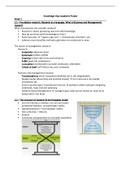Knowledge Clips Academic Project
Week 1
1.1 – Foundation research, Research as a language, What is (Business and Management)
research
What characterizes the scientific mindset?
Research is about producing new and valid knowledge
How do we know which knowledge to trust?
Rene Descartes “Cignito ergo sum” = I think/doubt, therefore I am.
Iedereen moet dezelfde methodes gebruiken om onderzoek te doen
The nature of management research
Research:
- Purposeful (altijd een doel)
- Systematic (telkens zelfde)
- Empirical (collect data from environment)
- Public (gaat niks verbeteren)
- Cumulative (voortbouwen op ouder onderzoek, uitbreiden)
- Critical of itself (zelf kritisch zijn, peer-reviewen)
Business and management research
- Transdisciplinary (moet toepasbaar/duidelijk zijn in alle vakgebieden)
- Double hurdle (theoretical and practical impact) het moet ook in de praktijk
uitvoerbaar zijn
- Science-practice gap / translational research bedrijven willen vaak geen langdurig
onderzoek, maar snel een oplossing
- Evidence Based Management managers gaan vaak op hun intuitie af, maar als je
bewijs hebt is het beter
1.2 – The structure of research & the Hourglass model
Eerst de literatuur induiken, het van een breder
perspectief bekijken, verwachtingen stellen
Operationaliseren = iets meetbaar maken
Data collection = Observe
Analyze
Conclusion and generalize to a broader population
, meeste artikelen hebben deze opbouw
Research reports typically take the form of an hourglass
The hourglass is useful for:
o Efficiently finding that information you are after
o Structuring your own report
o A research proposal is essentially a good first draft of the introduction and
method of the final report
1.3 – Types of research (and demands on design)
Basic research = satisfies curiosity
Applied research = find answers to ‘real life’ problems
Stronger evidence requires tougher designs
Types of studies
By evidence:
o Descriptive studies beschrijven van de ‘algemene’ populatie
o Relational studies tussen verschillende variabelen
o Explanatory / causal studies oorzaak-gevolg (moet je wel een longitudinaal
onderzoek doen)
By time:
o Cross-sectional (all data collected at one time). Cross-sectional studies cannot
be used to identify causal relationships
o Longitudinal (data collected over time)
Repeated measures (<20 measurement waves)
Time series (>20 measurement waves)
Qualitative data (‘build theory)
o Data that are in the form of text, pictures, sounds, etc.
o E.g. ‘friendly’, ‘outgoing’, ‘extraverted’, ‘interested’, ‘hardworking’
Quantitative data (‘test theory’)
o Data that is in numeric form
o A 3.79 on an extraversion scale ranging from 1 to 5 and a 9.35 on a job
performance scale ranging from 1 to 10.
,1.4 – The relationship between theory and data
The importance of Theory Good theory includes a plausible,
coherent, parsimonious explanation for why certain cause and
effect relationships should be expected. Or more prosaically it is
that which we think we know about a particular phenomenon
Soms loopt de rits vast
Je weet nooit iets zeker, maar er is wel een waarheid
Ockham’s razor: “all things being equal, the simplest solution tends to be the best one”
Inductive reasoning:
Observation Pattern Tentative hypothesis Theory
o Observeren/ondervragen: bijv van medewerkers, waarom ze ziek zijn
o Patroon: veel medewerkers lopen tegen hetzelfde probleem aan
o We can use inductive reasoning to generate theory
Deductive reasoning:
Theory Hypothesis Observation Confirmation
o Hypotheses door theorieën, daarna pas testen
o Eerst het probleem, dan kijken hoeveel mensen dit probleem hebben
o We can use deductive reasoning to test theory
Hypotheses
A specific statement of prediction
Alternative hypothesis = a specific statement of prediction stating what you expect
will happen in your study
Null hypothesis = a specific statement that predicts there will be no effect of a
program, treatment, or other independent variable you are studying (deze testen we
altijd, niet de alternatieve hypothese)
0= geen effect
1= sterk effect
+= positief effect
-= negatief effect
, 1.5 – Introduction to causality
Causality as the ‘holy grail’ of research
Quantitative variable
o The numerical representation of some object (e.g. extraversion, job
performance)
Attribute
o A specific value of a variable (e.g. male for the variable gender)
o A simplified way of thinking about a quantitative variable is that all attributes
are known and coded with a number prior to data collection (e.g. 0- female, 0
– male)
Independent variable
o The variable that you manipulate (the cause) (e.g. training 0-No 1-Yes)
Dependent variable
o The variable that is affected by the independent variable (the effect) (e.g.) job
performance)
Unit of Analysis
o The entitles about which we want to draw conclusions (e.g. person)
Causal Relationships as a special type of relationship
Not all relationships that we observe are causal
o Reversed causality (andersom), third variable, chance
We can design our research in such a way that we can rule out these alternative
explanations
o Isolation
o Temporal precedence (cause precedes the effect) oorzaak gaat vooraf aan
gevolg
1.6 – Introduction to conclusion, internal, construct, and external I
Validity: no study is perfect!
- Conclusion: is dat er een relatie is,
- Interne validiteit: is er een causale relatie?
- Construct validiteit: meet je wat je wilt meten? Gebruik je het juiste
meetinstrument?





